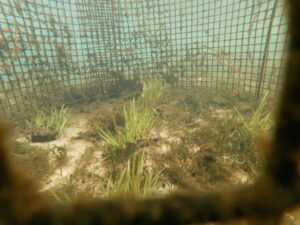UNDERWATER GRASS FARMING

Reestablishing healthy vibrant underwater grass meadows. It is what the Homosassa River Restoration Project is all about. We cannot just truck in a load of sod and throw it on the bottom of the river. Biologists must plant thousands of units of eelgrass by hand. The Homosassa River Restoration Project does not take grass from other ecosystems. All grass installed here is grown by Sea & Shoreline in Ruskin Florida.
But to grow and thrive grasses need strong root systems to survive hungry herbivores. That is why we spend so much time, effort, and resources to first remove the thick layer of muck that currently covers the bottom of the river and canals. The loose organic material removed is a poor base for a strong root system.

 EXCLUSION CAGES
EXCLUSION CAGES
Hungry manatees, birds, turtles, and yes people, can easily dislodge the plants. When possible, exclusion cages are installed to protect young grasses.

The minimum depth requirements for the installation of exclusion cages could not be met until recently. That limit, set by FWC, is 4 foot mean tide. Area’s “A”, “B”, and “C” were too shallow. Crews recently completed the cleaning of areas “D”, “E”, and “F” removing, in some cases, several feet of muck and detrital material. Biologists followed closely behind installing new grass along with exclusion cages. 
Why are the exclusion cages not marked by buoys or some other type of floating marker?
Sea & Shoreline is installing hundreds of exclusion cages during the restoration process. Many of them are within navigable channels and will remain on the bottom for at least 12 months. If all of the cages were marked it would pose a navigational nightmare.
How You Can Help
- When anchoring within the restored area’s please be on the lookout for exclusion cages.
- Please do not move or otherwise tamper with the cages.
- Go to the Homosassa River Restoration Project website to learn more.
- Donate
- Follow us on Facebook
